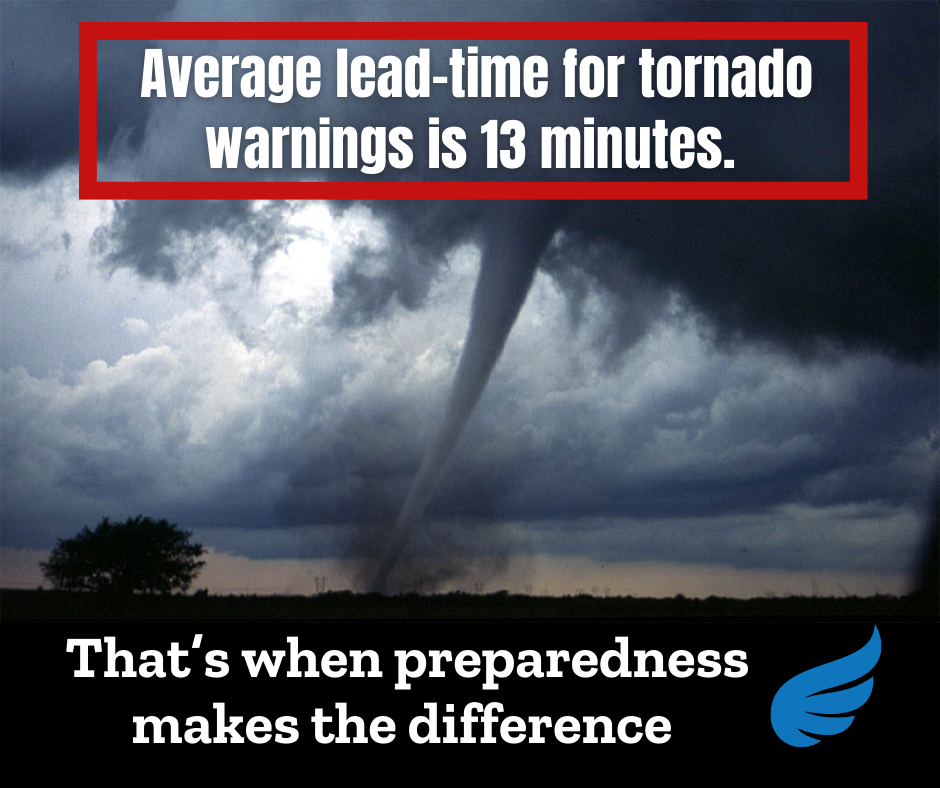TORNADO
A tornado is a vertical rotating column of air created during violent thunderstorms called supercells. Supercells contain a strong rotating updraft and can produce severe weather, including damaging winds, heavy rainfall, large hail, and ultimately tornadoes. The rotation of the supercell pulls in warm and humid air which collides with cold air and starts swirling around to develop an updraft. The movement enhances energy and increases speed. A condensation funnel made up of water droplets is created and makes its way down until it touches the ground at which point it becomes a tornado.
Characterized by extreme winds and because they are carrying dust and debris, tornadoes are among the most destructive of all atmospheric phenomena. The winds can reach speeds of up to 250 mph (400 km/h) with a path of destruction within 330 feet (100 meters) to 2.5 miles (4 km), tornado progression rarely exceeds 15 miles (25 km) in distance.
Tornadoes can occur whenever and wherever throughout the world when the conditions are met. However, the United States registers the most annually: an average of 1,200 tornadoes are reported each year in the “Tornado Alley”, in the central United States where they are most frequent. This area includes eastern Colorado, South Dakota, Nebraska, Kansas, Oklahoma, northern Texas, Louisiana. Tornadoes kill about 80 people and injure more than 1,500 nationwide each year, mostly from flying or falling debris.
Tornadoes can happen at any time but, according to the National Oceanic and Atmospheric Administration (NOAA), tornado season in the United States generally lasts from March through July.
Tornado alerts
In the US, tornado watches and warnings are issued by the National Oceanic and Atmospheric Administration (NOAA) Storm Prediction Center which watches the weather 24/7 across the entire country.
Tornado Watch
A tornado watch is issued for weather conditions that are favorable for tornadoes and severe weather. A watch usually covers many counties or even states. You need to get ready: check on the people around you, check your supplies, your emergency kits and your safe room.
Tornado Warning
A warning means that a tornado has been reported by local authorities or indicated by weather radar. A warning typically covers a smaller area, like a city or small county. There is imminent danger to life and property to those in the path of the tornado. According to the NOAA, the average lead-time for tornado warnings is 13 minutes. You need to take action immediately, take your emergency kits and move to your safe room.
Tornado strength scale
Tornado strength is rated according to the Enhanced Fujita (EF) scale. The rating is determined by wind speed and by the damage caused (28 damage indicators such as building type, structures and trees).
The Enhanced Fujita Scale (EF Scale)
EF0 - Light damage - Wind speeds between 65-85 mph (105-137 km/h) can peel the surface of roofs, brake tree branches.
EF1 - Moderate damage - Wind speeds between 86-110 mph (138-177 km/h) can severely stripped roofs, overturn mobile homes, shatter windows.
EF2 - Considerable damage - Wind speeds between 111-135 mph (178 km/h) can tear off roofs, destroy mobile homes, lift cars off the ground.
EF3 - Severe damage - Wind speeds between 136-165 mph (218-266 km/h) can destroy stories of well-constructed homes, damage large buildings.
EF4 - Devastating damage - Wind speeds between 166-200 mph (267-322 km/h) can level well-constructed homes, propel cars through the air.
EF5 - Incredible damage - Wind speeds greater than 200 mph (322 km/h) can level off and sweep away strong frame houses, significantly damage high-rise buildings.


